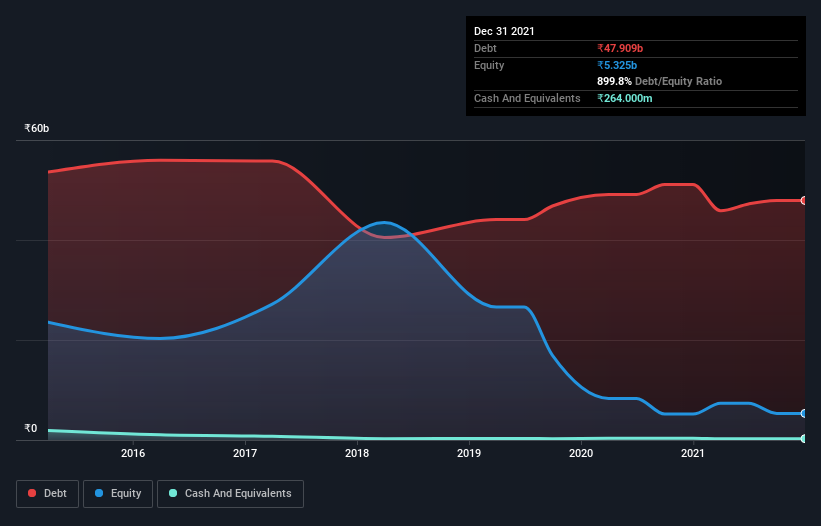Health Check: How Prudently Does Bombay Rayon Fashions (NSE:BRFL) Use Debt?

Warren Buffett famously said, 'Volatility is far from synonymous with risk.' So it seems the smart money knows that debt - which is usually involved in bankruptcies - is a very important factor, when you assess how risky a company is. Importantly, Bombay Rayon Fashions Limited (NSE:BRFL) does carry debt. But should shareholders be worried about its use of debt?
Why Does Debt Bring Risk?
Generally speaking, debt only becomes a real problem when a company can't easily pay it off, either by raising capital or with its own cash flow. If things get really bad, the lenders can take control of the business. However, a more frequent (but still costly) occurrence is where a company must issue shares at bargain-basement prices, permanently diluting shareholders, just to shore up its balance sheet. Having said that, the most common situation is where a company manages its debt reasonably well - and to its own advantage. When we examine debt levels, we first consider both cash and debt levels, together.
See our latest analysis for Bombay Rayon Fashions
How Much Debt Does Bombay Rayon Fashions Carry?
You can click the graphic below for the historical numbers, but it shows that Bombay Rayon Fashions had ₹47.9b of debt in September 2021, down from ₹51.1b, one year before. And it doesn't have much cash, so its net debt is about the same.

How Healthy Is Bombay Rayon Fashions' Balance Sheet?
The latest balance sheet data shows that Bombay Rayon Fashions had liabilities of ₹44.7b due within a year, and liabilities of ₹9.56b falling due after that. Offsetting these obligations, it had cash of ₹264.0m as well as receivables valued at ₹12.1b due within 12 months. So its liabilities outweigh the sum of its cash and (near-term) receivables by ₹41.9b.
This deficit casts a shadow over the ₹2.13b company, like a colossus towering over mere mortals. So we'd watch its balance sheet closely, without a doubt. After all, Bombay Rayon Fashions would likely require a major re-capitalisation if it had to pay its creditors today. There's no doubt that we learn most about debt from the balance sheet. But you can't view debt in total isolation; since Bombay Rayon Fashions will need earnings to service that debt. So when considering debt, it's definitely worth looking at the earnings trend. Click here for an interactive snapshot.
In the last year Bombay Rayon Fashions had a loss before interest and tax, and actually shrunk its revenue by 49%, to ₹864m. That makes us nervous, to say the least.
Caveat Emptor
Not only did Bombay Rayon Fashions's revenue slip over the last twelve months, but it also produced negative earnings before interest and tax (EBIT). Its EBIT loss was a whopping ₹3.7b. When you combine this with the very significant balance sheet liabilities mentioned above, we are so wary of it that we are basically at a loss for the right words. Like every long-shot we're sure it has a glossy presentation outlining its blue-sky potential. But on the bright side the company actually produced a statutory profit of ₹460m and free cash flow of ₹3.6b. So its situation may not be as precarious as the EBIT would imply. The balance sheet is clearly the area to focus on when you are analysing debt. However, not all investment risk resides within the balance sheet - far from it. We've identified 4 warning signs with Bombay Rayon Fashions (at least 1 which is a bit concerning) , and understanding them should be part of your investment process.
When all is said and done, sometimes its easier to focus on companies that don't even need debt. Readers can access a list of growth stocks with zero net debt 100% free, right now.
If you're looking to trade Bombay Rayon Fashions, open an account with the lowest-cost platform trusted by professionals, Interactive Brokers.
With clients in over 200 countries and territories, and access to 160 markets, IBKR lets you trade stocks, options, futures, forex, bonds and funds from a single integrated account.
Enjoy no hidden fees, no account minimums, and FX conversion rates as low as 0.03%, far better than what most brokers offer.
Sponsored ContentValuation is complex, but we're here to simplify it.
Discover if Bombay Rayon Fashions might be undervalued or overvalued with our detailed analysis, featuring fair value estimates, potential risks, dividends, insider trades, and its financial condition.
Access Free AnalysisHave feedback on this article? Concerned about the content? Get in touch with us directly. Alternatively, email editorial-team (at) simplywallst.com.
This article by Simply Wall St is general in nature. We provide commentary based on historical data and analyst forecasts only using an unbiased methodology and our articles are not intended to be financial advice. It does not constitute a recommendation to buy or sell any stock, and does not take account of your objectives, or your financial situation. We aim to bring you long-term focused analysis driven by fundamental data. Note that our analysis may not factor in the latest price-sensitive company announcements or qualitative material. Simply Wall St has no position in any stocks mentioned.
About NSEI:BRFL
Bombay Rayon Fashions
Bombay Rayon Fashions Limited, an integrated textile company, manufactures and sells yarns, fabrics, and garments in India.
Overvalued with weak fundamentals.
Similar Companies
Market Insights
Community Narratives



